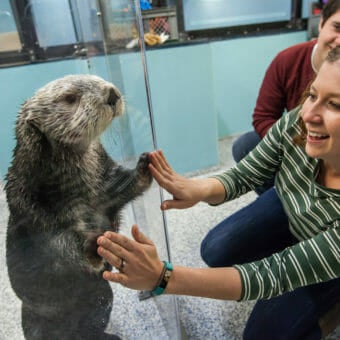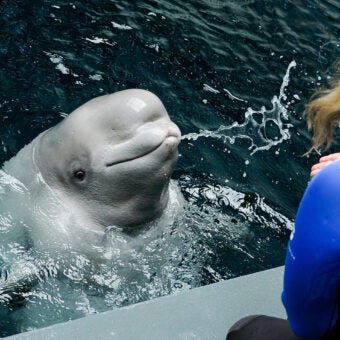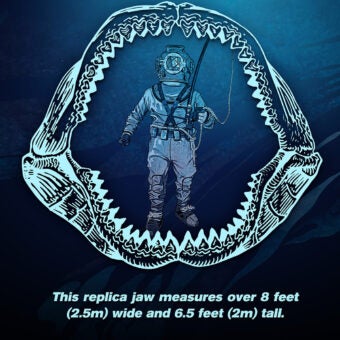-
Size
4 feet (1.2 m) long -
Diet
Sea urchins and other invertebrates -
Range
Northern Pacific Ocean and southern Bering Sea -
Habitat
Marine habitat with rocky or muddy sea bottoms and kelp forests
Physical Characteristics
Size
- Adult southern sea otters are approximately 4 feet (1.2 m) in length. Adult males average 65 lbs. (29.5 kg) and adult females average 45 lbs. (20 kg) in weight.
- A newborn southern sea otter pup is a buff color, 22 to 24 inches (55-60 cm) in length and 4 to 5 lbs. (1.8-2.3 kg).
Color
- The southern sea otter is dark to reddish brown in color with a lighter-colored head, throat, and chest.
Body Composition
- It has a long, stout body with a short broad head and snout with thick whiskers on the cheeks.
- The tail is short in comparison to those of other otters.
- Webbed hind feet that can be spread wide like flippers are well adapted for swimming.
- Forepaws are smaller with retractable claws and are used to groom, eat, and hold tools for breaking open prey.
- Classified as a marine “fissiped”, the sea otter is an aquatic carnivore that is well-adapted for its life at sea. The digits on its front paws are separated and covered, similar to mittens. Its claws are retractable and the front paws have rough pads. These features help sea otters more easily grasp their slippery or spiny prey. On the hind paws, the pads are reduced and may be absent, except on the toes. The fifth digit or little toe is longer than all other otters, allowing the sea otter to spread its webbing wider when swimming.
Teeth
- The majority of the southern sea otter’s teeth are flattened molars for crushing and chewing shelled, invertebrate prey. The otter has a set of canine teeth as well.
- Major tooth wear is a cause of mortality in older otters.
- Webbed hind feet that can be spread wide like flippers are well adapted for swimming.
Fur
- The sea otter’s body is covered in dense fur that constantly must be groomed to maintain its insulating properties and cleanliness; therefore, a sea otter will spend a large amount of time grooming.
- This thick coat helps to maintain its body temperature in cold ocean water.
- The fur of the sea otter is the densest of all mammals at about 350,000 to 1,000,000 hairs per square inch, compared to dogs which only have 1,000 to 60,000 hairs per square inch.
- The sea otter’s fur also is designed to trap air to further insulate it from the cold water and to provide additional buoyancy.
Animal Fact
Southern sea otters can store food in "pockets" under their foreleg.
Diet / Feeding
Diet
- Southern sea otter consumes many types of prey including sea urchins, snails, clams, abalone, mussels, crabs, scallops, fish, barnacles, octopus, worms, and squid, which it captures with their clawed paws, not their jaws.
- They must eat 20% to 25% of their body weight every day to maintain normal body temperature, so they will spend much of the day foraging.
- This species is considered a keystone species and helps maintain the health of kelp forests by preying on sea urchins, which, if allowed to proliferate, can destroy a kelp forest. The urchin feeds on the holdfast or base of young kelp, which can set it adrift. An adult male sea otter may eat as many as 50 urchins each day.
Feeding behaviors
- They use rocks, shells and other hard materials from the ocean floor as shell-crushing tools, while balancing their prey on their chest and stomach.
- Studies on southern sea otters in California have shown that diet can be a highly individual thing, in which an otter will specialize in one to three types of prey that are not influenced directly by prey availability. However, most individuals will take advantage of seasonally abundant swells in prey species, such as squid and red crab.
- Uses their nose and whiskers to help locate prey and to detect vibrations under the water. They also use a flap of skin located under each foreleg to hold food temporarily while hunting until they return to the surface.
Range / Habitat
Range
- The sea otter is found along coastal areas of the northern Pacific Ocean and the southern Bering Sea. Three separate subspecies live along the coasts of Russia, Alaska, and California. Reintroduced populations in British Columbia and Washington state.
Distribution
- The southern subspecies lives along the central California coast from San Mateo County to Santa Barbara County. Historically, the range extended from Punta Abra Ojos, Baja California north to Prince William Sound Alaska.
Habitat
- Found in marine habitats with rocky or muddy sea bottoms and is frequently associated with kelp forests. Rarely ventures onto land.
Reproduction & Growth
- Females give live birth to, normally, one pup at a time.
- Pups remain dependent upon their mothers for approximately six months.
Additional Information
Lifespan
- Males live about 10 to 15 years in the ocean, while females’ lifespans can be a little longer. Their lives are usually longer in an aquarium or zoo setting.
Reproduction
- During the mating season, the male bites the snout of the female in a display of courting behavior. Consequently, sexually mature females can be distinguished by scarred nose regions.
- Female sea otters are typically pregnant for four and a half months.
- Delayed implantation periods in sea otters depend on individual and geographic variation. It ranges from two to three months in southern sea otters and can last as long as eight months in northern sea otters.
- Sea otter pups can emit a strong high-pitched call when in distress or separated from their mother. They are nursed by their mother for six months to a year, but can begin foraging in shallow water habitats as soon as six weeks after birth.
Social Behavior
- It is believed that a sea otter will wrap itself with kelp before sleeping at the surface to keep itself from drifting away.
- The southern sea otter is not a social animal as are other otter species and has been known to live alone. However, it frequently occurs in small groups where food sources are plentiful and will rest in a group called a “raft.”
- Males usually raft together during the non-breeding season.
- Adult males are highly territorial during the breeding season and will not permit other males to enter their territory.
- Females raft with their pups and other females.
- Although the pup ratio is about 50:50 male to female, there is a higher mortality rate among male pups. This results in a higher female-to-male ratio in adults.
Diving
- This otter can dive to 300 feet (91 m) in search of food.
- Southern sea otters can dive for over 5 minutes at a time but will typically stay submerged for less than a minute.
Metabolism
- The southern sea otter has a high metabolic rate that is about 2.5 times greater than that of other terrestrial animals of the same size. The hind feet and front paws lose the most heat because fur is sparse or absent, so the sea otter often can be seen holding them out of the water to conserve body heat while it floats on its back at the surface.
Senses
- Hearing, smell, touch and sight are very well developed in the sea otter and are important in hunting as well as in detecting danger.
Family
- Southern sea otter belongs to the family Mustelidae, the same as weasels and wolverines.
Conservation Status
Conservation Status
- “Endangered” on the IUCN Red List.
- Enhydra lutris nereis is listed on Appendix I of CITES. The other subspecies of sea otters are Appendix II.
- Listed as “threatened” under the U.S. Endangered Species Act and “depleted” under the U.S. Marine Mammal Protection Act of 1977.
Threats
- Potential current threats to this protected subspecies include entanglement in fishing nets, oil spills and predation by the great white shark.
- Once common along most of the coastal North Pacific Ocean from Japan to California, in the nineteenth and early twentieth centuries, it was hunted to the verge of extinction for its prized pelt.
Sources
- www.iucnredlist.org
- www.cites.org
- National Audubon Society Guide to Marine Mammals of the World. Reeves, R. R., et al.
- Marine Mammals of the World. Nowak, R. M.
- National History of Otters. Chanin, P.
- Marine Mammal Encyclopedia, Otters. Estes, James A. and Bodkin, James L.



